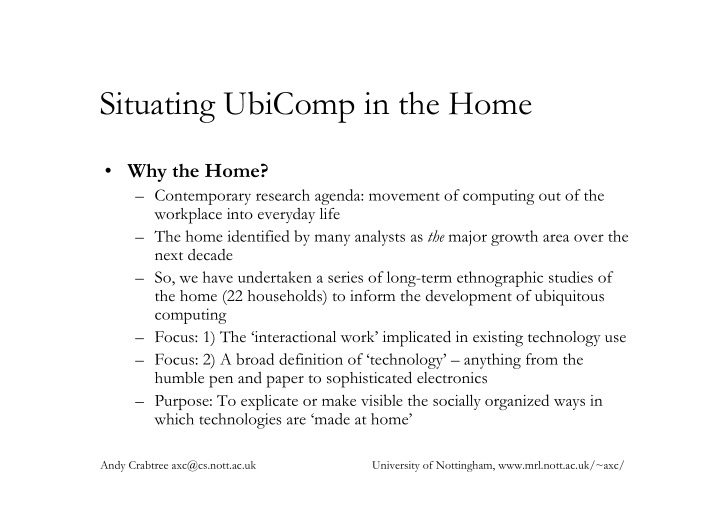



Situating UbiComp in the Home • Why the Home? – Contemporary research agenda: movement of computing out of the workplace into everyday life – The home identified by many analysts as the major growth area over the next decade – So, we have undertaken a series of long-term ethnographic studies of the home (22 households) to inform the development of ubiquitous computing – Focus: 1) The ‘interactional work’ implicated in existing technology use – Focus: 2) A broad definition of ‘technology’ – anything from the humble pen and paper to sophisticated electronics – Purpose: To explicate or make visible the socially organized ways in which technologies are ‘made at home’ Andy Crabtree axc@cs.nott.ac.uk University of Nottingham, www.mrl.nott.ac.uk/~axc/
Study Policy • Here’s an object introduced into a world. And it’s a technical thing which has a variety of aspects to it. Now what happens is, a culture secretes itself onto it in its well-shaped ways [and it develops] into something with its own social structure. And that’s a thing that’s routinely being done, and it’s the source for the failures of technocratic dreams that if only we introduced some fantastic new machine the world will be transformed. Where what happens is that the object is made at home in the world that has whatever organization it already has . Harvey Sacks (edited and emphasis added) Andy Crabtree axc@cs.nott.ac.uk University of Nottingham, www.mrl.nott.ac.uk/~axc/
Moving Beyond Abstract Statements • A practical example: mail – The current organization of electronic mail in the home: computing in a corner or some other outpost – Contrast this with the social organization of paper mail Andy Crabtree axc@cs.nott.ac.uk University of Nottingham, www.mrl.nott.ac.uk/~axc/
Handling Paper-based Mail (1) • #1. Collection – A known in common delivery / collection point – Obviously contingent on nature of particular home – Access to mail is far less contingent – just about any household member may The Porch collect mail, but not any may open it Andy Crabtree axc@cs.nott.ac.uk University of Nottingham, www.mrl.nott.ac.uk/~axc/
Handling Paper-based Mail (2) • #2. Seeing Relevance – Opening mail is not governed by recipient name but by entitlements to open mail – The visibility of the practical character of mail (conveyed by logos, organizational stamps, postmarks, and The Phone Bill handwriting, etc.), articulates entitlement rights Andy Crabtree axc@cs.nott.ac.uk University of Nottingham, www.mrl.nott.ac.uk/~axc/
Handling Paper-based Mail (3) • #3. Displaying Relevance for Others in General – The person who opens and / or sorts the mail is not necessarily the recipient of the mail – Mail is subsequently placed at known in common sites to display its relevance to Mail for Others in General others Andy Crabtree axc@cs.nott.ac.uk University of Nottingham, www.mrl.nott.ac.uk/~axc/
Handling Paper-based Mail (4) • #4. Displaying Relevance to Particular Household Members – The placement of mail for others is done in fine-grained ways to display the relevancy status of mail – For example, a card from a family friend may be placed by one partner at the other’s seat at Mail for a Particular Other the table to draw attention to its particular relevance Andy Crabtree axc@cs.nott.ac.uk University of Nottingham, www.mrl.nott.ac.uk/~axc/
Handling Paper-based Mail (5) • #5. Displaying Relevance to Action – Opened mail is placed to articulate at-a-glance the actions that need to be taken in response – For example, a bill may be placed at the front of the table to show that it Placing Mail for External Use needs to be taken out of the home and paid Andy Crabtree axc@cs.nott.ac.uk University of Nottingham, www.mrl.nott.ac.uk/~axc/
Handling Paper-based Mail (6) • #6. Different Displays for Different Actions – Certain mail, particularly various cards (birthday, greetings, postcards, etc.) are placed to display them after they have been read – For example, on the mantelpiece, where they also Placing for Aesthetic & serve as reminders Mnemonic Display Andy Crabtree axc@cs.nott.ac.uk University of Nottingham, www.mrl.nott.ac.uk/~axc/
Handling Paper-based Mail (7) • #7. Displaying Items ‘Pending’ Action – Mail that requires no immediate action is placed on a pending pile, which reflects outstanding tasks to be done – For example, it may be The Pending Pile placed at the back of the kitchen table Andy Crabtree axc@cs.nott.ac.uk University of Nottingham, www.mrl.nott.ac.uk/~axc/
Handling Paper-based Mail: An Instance of Interface Construction (8) • #8. Displaying Items of Short-term Relevance – Mail that is not of immediate relevance but which members need to be aware of is placed in a location that maintains its visibility Mail of Short-term Relevance – For example, on a noticeboard Andy Crabtree axc@cs.nott.ac.uk University of Nottingham, www.mrl.nott.ac.uk/~axc/
“The technology is made at home in a world that has whatever organization it already has” • The organization: an ecologically distributed network of coordinate displays that ‘mark out’ and ‘track’ what stage a job-to-do has reached Email: A Distinct Lack of Resonance Organization of Paper Mail Here & Now Andy Crabtree axc@cs.nott.ac.uk University of Nottingham, www.mrl.nott.ac.uk/~axc/
Recommend
More recommend